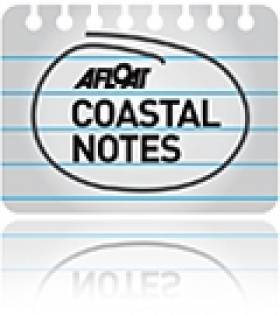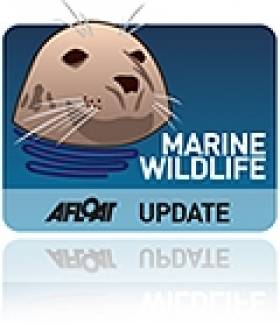Displaying items by tag: Fáilte Ireland
The Return of the 'Wexford' Tall-Ship
A grant of €1m from Fáilte Ireland was allocated towards the cost of the refit as part of the National Development Plan (NDP). Visitors can now take guided tours of the floating tourist attraction though access to the shoreside visitor centre remains closed due to an upgrade. Work on an extension of a new exhibition centre is expected to be completed in May or June.
Dunbrody is a full scale reconstruction of the 19th century replica famine-ship based on the vessel built in 1845 in Quebec, Canada for the Graves family of New Ross. Ireland's most inland port being made famous with the visit of President John F. Kennedy in 1963 to the same quayside where Dunbrody is berthed.
To date the Dunbrody's presence outside her homeport has been scarce. During the Waterford Tall Ships Festival in 2005 she took part in a memorable and historic 'Parade of Sail' where she formed as part of the trio of Irish tall ships that met together for the only time. The sailing spectacle of the international fleet was headed firstly by the Irish trio with Asgard II leading followed by Dunbrody and astern the Jeanie Johnston.
In the following year Dunbrody made her maiden and only international voyage to Milford Haven in south Wales. The Pembrokeshire estuary had hosted the new festival, Seafair Haven. On that occasion she had the honour of leading another parade of sail, under the command of Captain Tom McCarthy.
Dunbrody was last dry-docked in 2006 and also at the New Ross boatyard which lies on the Co. Kilkenny side of the riverbank. The 176 foot / 54 metre barque was built in 2001 and was last vessel completed at the boatyard. During her building the public could access the yard and the construction process could be viewed from above at a gallery set within the covered building hall.
The structure no longer exists but which was built originally for the Ross Company boatyard during the 1970's. The yard specialised in building barge pontoons for markets in the North Sea until the premises closed in the 1980's. In recent years and under new management the dry-dock (75m X 15m) has been upgraded with a new gate and pump.
Looking for further reading on Tall Ships in Ireland? Click the links below:
Click this link to read all our Tall Ships Stories on one handy page
Previewing Ireland's Tall Ships 2011 Season
Can Ireland Get a New Tall Ship?
- Asgard II
- Jeanie Johnston
- river barrow
- New Ross
- River Suir
- Milford Haven
- Ports and Shipping News
- barque
- Fáilte Ireland
- Dunbrody
- Parade of Sail
- Brigantine
- Waterford Tall Ships Festival
- Dunbrody Heritage Centre
- River Nore
- New Ross Boat Yard
- Sea Haven
- National Development Plan
- NDP
- President John F. Kennedy
- Capt. Tom McCarthy
- Ross Company
- Seafair Haven
Clare County Council Approves Doolin Development
The controversial €6 million deveopment of Doolin Point has been backed unanimously by Clare councillors.
Clare county manager Tom Coughlan had recommended giving approval for the revised plan, which was submitted after surfers expressed concerns over the impact of the original scheme on waves in the area.
The scheme has already received support from the Doolin Coast Guard Unit and local tourism and business groups.
But according to The Irish Times, the Irish Surfing Association (ISA) maintains that even the amended plans – which move the new pier 25m further away from the surf – would destroy the "world renowned" Crab Island and Doolin Point waves.
The ISA and West Coast Surf Club have warned the council that loss of the waves could cost up to €33 million per year in revenue generated by surf tourism in the area - a concern backed by Fáilte Ireland.
The Doolin Point pier project must be completed by the end of this year in order for the council to draw the €6 million in Government funding required.
Waterford Tall Ships Plans Revealed
Waterford has unveiled its sailing plans to celebrate the arrival of the Tall Ships Race this summer.
The Irish Times reports that more than half a mllion people are expected to visit the city from 30 June to 3 July to see the majestic vessels - and they are set to be entertained by a variety of street events and live performances.
Sharon Shannon, The Waterboys and magician Keith Barry are among those lined up for the weekend's festivities.
Fáilte Ireland chair Redmond O’Donoghue compared the Tall Ships visit to the Volvo Ocean Race visits to Galway, and said it would be “a talking point for many years to come”.
A new multi-million euro jetty for Waterford Harbour designed to accommodate the ships will be ready in time for the race arrival.
The Irish Times has more on the story HERE.
Looking for further reading on Tall Ships in Ireland? Click the links below:
Click this link to read all our Tall Ships Stories on one handy page
Previewing Ireland's Tall Ships 2011 Season
Can Ireland Get a New Tall Ship?
Fáilte Ireland in Whale Advert Gaffe
Fáilte Ireland has come under fire for an advert that shows a whale that cannot be found in Irish waters.
According to the Irish Examiner, the Irish Whale and Dolphin Group (IWDG) has questioned by images of humpback or fin whales, which are a common sight off Ireland's coast, were not used instead.
The IWDG'sSimon Berrow said: "It’s great that we are promoting marine tourism but if we are serious about it, let’s do it properly."
Last year Fáilte Ireland was criticised for a similar advertisement that used stock footage of a whale species not found in Ireland.
The Irish Examiner has more on the story HERE.
Cork Clipper Brings €5.6m in Economic Return to the Local Economy
An economic impact analysis was carried out by three MBS students from University College Cork (Ger Swayne, Lorcan Daly & Stephen Hicks) which reported an economic impact of €5.6m with accommodation and food and beverage accounting for 65% of the figure. The students worked according to the standard Failte Ireland festival report methodology which includes qualitative and quantitative research.
At today's launch Deputy Mayor Of County Cork Cllr John O Sullivan stated 'the festival gave a great boost to the Kinsale area early in the summer season and it also ensured that works were carried out in the town prior to the event that benefitted both locals and visitors. In particular the refurbishment of the Old Mill as an exhibition venue was a huge new resource for the town.'
The media report was carried out by IFM Sports Marketing Surveys and was commissioned by Clipper Ventures who run the Clipper Round the World Yacht Race. Global media coverage for the whole race is estimated at over $100m and Cork's share of this is very substantial at $26.5m. These figures are boosted by a Discovery Channel global deal that has been agreed with the TV series producers and Clipper Ventures. An Irish broadcaster for the series will be announced in the coming weeks.
Commenting on today's results, Fiona Buckley, Head of Operations, Fáilte Ireland stated 'from a tourism perspective the media coverage that Kinsale, Cork and the region received through the Clipper project will ensure that Cork is top of mind as a tourism destination in the coming years. In addition the economic report found that 98% of the overseas visitors would return to Cork as a result of the Clipper festival and 97% would recommend Cork to their friends.'
The festival in Kinsale was helped by the arrival of the fleet of 10 Clipper yachts six days ahead of schedule and the fantastic weather during that period. When the yachts moved to the new Port of Cork Marina on 07 July the weather changed dramatically and this had an impact on the attendance figures in the city.
'When the fleet arrived in Cork city there was a crowd of over 10,000 people to welcome the fleet to the new Cork City Marina which was installed to welcome the Race but is also a lasting legacy to marine tourism in the region. We would like to thank the Port of Cork for investing in this new permanent infrastructure with the support of Cork City Council.
This new Marina will play host to other marine events over the coming years.' Stated Lord Mayor Cllr Michael O Connell Clipper Race Chairman, Sir Robin Knox-Johnston, said, "Cork and Kinsale were fantastic hosts, providing marvellous entertainment during
the race festivals in both locations and I am pleased to see that they reaped the rewards. The welcome visitors received will ensure a lasting tourism legacy for years to come. "
The return on investment for the project is estimated at over 300% which is above average for hosting a sporting event of this calibre.

































































